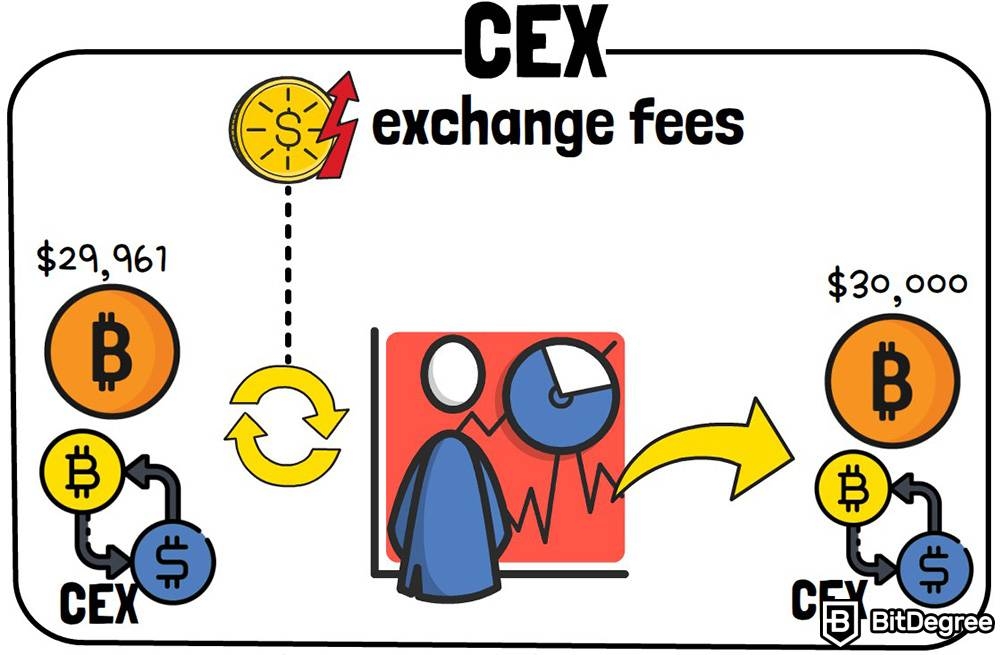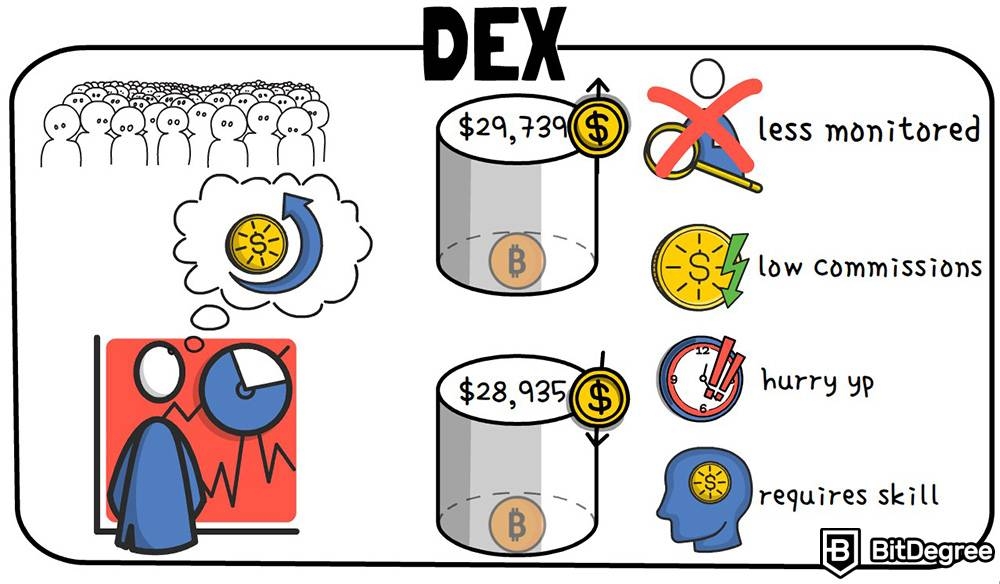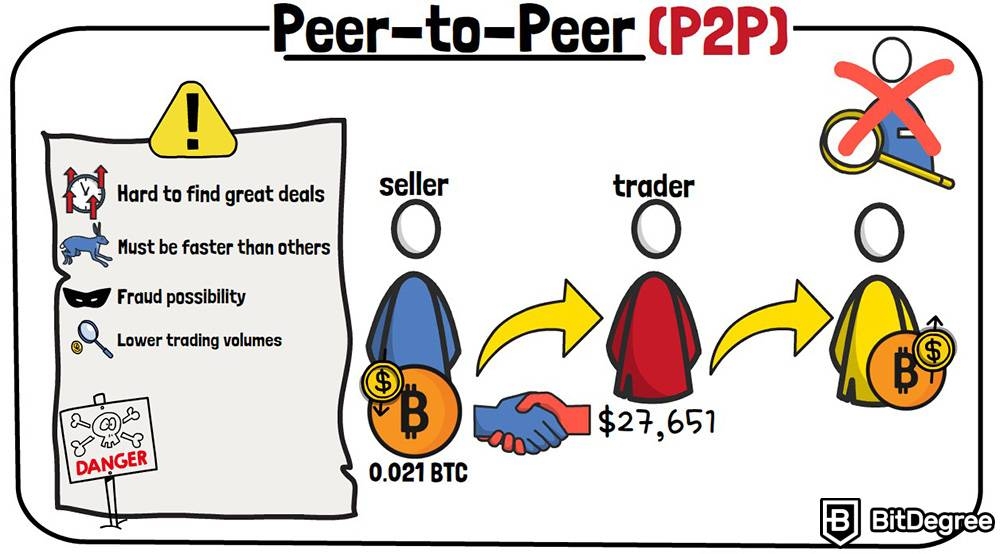What is Crypto Arbitrage: The Main Principles
In this section, we’re going to talk about how to arbitrage crypto!
For newcomers, crypto arbitrage may sound off-putting, daunting even. But there’s no need for that. Once you understand the gist of things, it becomes intriguing. Crypto arbitrage is about being the smartest and the fastest in the room. And you’ll see what kinds of challenges await those who are willing to enter the territory of this unpredictable trading strategy.
Many people postpone learning about how to participate in crypto arbitrage simply because they’re afraid they won’t understand it. But even the pros once started at the beginning! And today, I’m about to present to you this topic in an accessible manner, and help you discover how captivating it can be!
In this section, we’re going to take a deeper look not only into the crypto arbitrage’s theoretical foundations, but also comparisons and real-life examples. Then, I’ll cover how to find arbitrage opportunities, and what challenges await those who partake in it.
Without further ado, let’s get to it!

Video Explainer
Video Explainer: What is Crypto Arbitrage: The Main Principles
Reading is not your thing? Watch the "What is Crypto Arbitrage: The Main Principles" video explainer
What is Crypto Arbitrage? (Risks & Tips Explained With Animation)


What is Crypto Arbitrage?
So, what is crypto arbitrage?
Put simply, crypto arbitrage is a trading strategy. It refers to traders taking advantage of price differences in asset prices across different cryptocurrency exchanges. In practical terms, it means buying crypto on some platforms for one price, and selling it on other platforms for a higher price. The difference between the prices is the profit that crypto arbitrageurs end up with.

How about a down-to-earth example? This is Tony. Summer is approaching, so his coworkers begin talking about buying a new bike. Tony senses a new opportunity to make a profit. So, he scans the market, and finds that there’s a less-than-popular bicycle shop, around 100 miles away. And here’s the catch: bikes are cheaper over there, when compared to the local shops around the area where Tony lives.
So, instead of paying $500 for a bike locally, Tony goes out to this spot, and gets one for $400. He brings it back, and sells it for the local price of $500, thus making a profit of $100.
This is the basic concept of arbitrage, which can be applied to various markets and industries. You could even say that Tony has just participated in some kind of “bicycle arbitrage”. Now, change “bicycle” with “crypto”, and you’ll get closer to what crypto arbitrage is all about.
Moving on, let’s go for a crypto-related example. Imagine Bitcoin is trading at $22,000 on Exchange X, and $23,000 on Exchange Y. So, a trader would buy 1 Bitcoin on Exchange X, transfer it to Exchange Y, and sell it. The result is a $1,000 profit.
Do keep in mind, though, that there are costs that are not evident at first sight. Just like it’s essential to think of the transportation costs, storage and taxes when buying a bike, it’s just as critical not to forget about the associated fees when participating in crypto arbitrage, as well. But more about it later.
Arbitrage Opportunities
The next thing to discuss is the question of where and how to find arbitrage opportunities in crypto. If it was that easy, everyone would be going all-in on crypto arbitrage. But the more you get to know about this trading style, the more you realize why it’s definitely not a beginner-friendly crypto trading strategy.
So, why is that the case?

Exchange fees, for example, are enough to make it almost impossible to engage in crypto arbitrage on centralized crypto exchanges. The coin and token price variations on different CEXs are minor, and by buying assets, transferring and selling them, you would have to deal with several exchange fees, which could kill all of your potential financial gains.
Therefore, crypto arbitrage requires more focus on something a bit more intricate than CEXs. For example, DEXs, or decentralized exchanges.
By the way, if you feel like your knowledge about CEXs and DEXs could use some refreshing, be sure to check out this section. It covers everything you need to know about crypto exchange platforms!

Now, let's get back to arbitrage opportunities. Crypto traders go to DEXs because, usually, they have different liquidity pools from those of centralized exchanges. This is important, because this affects the asset price for which it’s being sold on the DEX. So, different liquidity pools lead to the possibility of the same asset being traded at different prices on different DEXs. And different prices mean arbitrage opportunities.
What’s more, DEXs are often less organized and less monitored than centralized exchanges, and this makes it more likely that price differences will arise.
And it’s worth mentioning that, unlike centralized exchanges, decentralized exchanges are more likely to apply lower commissions.
Naturally, these opportunities are not long-lived. If they were, everyone would just capitalize on them until the liquidity pools dried out. Therefore, it takes a skillful arbitrage trader to identify these opportunities, make an informed decision, and act upon it quickly.
But there’s more to it than just decentralized exchanges. Another way to look for crypto arbitrage opportunities is to go to Peer-to-Peer (or, more commonly known as “P2P”) platforms.

Unlike crypto exchanges, centralized or decentralized, P2P platforms allow individuals to directly exchange cryptocurrencies with each other without the need for an intermediary. This means that traders can execute trades for different prices, which can create price discrepancies for the same asset.
On a side note, if you feel like learning more about P2P platforms wouldn’t hurt, be sure to check out this section about different ways of trading cryptocurrencies - it will help you develop a better understanding of how to arbitrage crypto, as well!
Okay, back to the subject. So, P2P arbitrage happens when a trader finds a seller on one P2P platform offering a crypto asset at a lower price than the market rate, buys it, and then immediately sells the same cryptocurrency on another P2P platform at a higher price.
Yet, P2P arbitrage opportunities come with a handful of risks. First of all, it takes time to find these traders who are willing to sell assets for a price that is lower than the market rate.
Not only that, traders have to be really quick after identifying such situations, because, during moments of hesitation, other traders would simply snatch this opportunity from right in front of their eyes.
The risk of fraud on P2P platforms must also be mentioned. It’s a Peer-to-Peer kind of a deal, so you never know what kind of tricks the other party is about to pull out of their sleeve. Thus, P2P arbitrage requires extra caution.
Finally, P2P trading platforms usually have lower trading volumes than, let’s say, centralized or decentralized exchanges. You can buy just as much as the seller offers, not more. This, therefore, imposes limits on potential arbitrage gains.
But, there’s one huge drawback when it comes down to manual research of arbitrage opportunities. It takes a lot of time. And when it comes to locating, identifying, and executing a deal… Humans can’t beat machines. If new traders relied entirely on themselves, they would soon see losses, and run into the question of “what is wrong with arbitrage trading in crypto?”.
Of course, smart arbitrage traders have employed cutting-edge technology to be unbeatable in this game. I’m talking about arbitrage bots.

Just like it sounds, arbitrage bots refer to automated trading programs that are designed with one specific purpose in mind: to take advantage of asset price differences between different cryptocurrency exchanges. If a minor price difference occurs, you can be sure that a bot will detect it quicker than your average human arbitrage trader.
Arbitrage bots use sophisticated algorithms to identify these opportunities and execute trades quickly and automatically, without the need for human intervention. This not only cuts out the need for manual research, but also removes the element of hesitation. In many cases, slow decision-making would simply end up in a lost arbitrage opportunity. Bots solve this problem, at least to an extent.
Once a price difference is located, the bot executes the deal. The freshly-made money ends up in the pocket of the one who employed, or, in many cases, created the arbitrage bot themselves.
To put things in perspective, here are some real-life examples of how efficient these bots can be.
Dmitrii Ushakov, a Russian trader, has reportedly made $1.8 million in profit in just one month of using arbitrage bots. He used these bots precisely to monitor the price differences in the Bitcoin and Ethereum markets across exchange platforms.
Or, consider this. A group of traders from the University of California made a fortune thanks to arbitrage bots. They developed the bots, let them loose, and, during the course of several months, ended up with over $50,000 in their pockets.
So questions arise. Why bother with learning how to participate in arbitrage in crypto? Why not learn how to build a crypto arbitrage bot by yourself? Why isn’t everyone using them? Yes, traders can go on and buy themselves a bot or two. But, quite naturally, the best bots are not for sale.
Why sell them for money, when the bot itself can go on, and generate that money on its own? That’s why all the market-ready arbitrage bots are watered-down versions of those that are not for sale.
Challenges & Risks
Nevertheless, there is something that connects every way of participating in crypto arbitrage. Be it opportunities on DEXs, P2P platforms, or even access to arbitrage bots, as you learn how to arbitrage crypto, you will soon start to notice - they all run into the same challenges. That’s right, crypto arbitrage is full of obstacles that can ruin even the most promising chances of making a profit.
For starters, the crypto market is hyper-volatile. This means that price discrepancies, which are the reason why crypto arbitrage is even possible, disappear super quickly. And, sometimes, even immediate action isn’t enough.
Why? Well, for example, sometimes, a bridge between blockchains, a solution to bring tokens from one blockchain into another, may run into technical problems when processing such transactions. The tokens could get stuck on it, leaving the trader with their money hanging in the air. And time spent on retrieving it would result in a wasted arbitrage opportunity, since the price differences would fluctuate in the meantime.
As mentioned previously, arbitrage gains can often be killed by transaction fees. That’s why traders opt for less expensive options that are easier to be found on DEXs or P2P platforms. But even then, the problem of fees is not fully avoided.
You see, each transaction is a taxable event, state tax jurisdiction-wise. This means that crypto arbitrage trading is subject to regulatory oversight, which usually varies in different regions of the world.
Therefore, traders from different countries need to make sure that they comply with all applicable laws and regulations, and that they’re aware of the taxes that they’ll have to pay on all the money they’re about to make. If this is ignored, such “unexpected fees” could really take a toll on a trader's gains, no pun intended.
Wrapping Up
Wrapping things up, as you can see, crypto arbitrage can be a really lucrative way of approaching crypto, and there’s no correct way of how to do arbitrage in crypto. But, in order to execute such a trading strategy successfully, crypto traders really need to step up their game, be well-prepared, knowledgeable, and have a lot of hands-on experience and awareness about the risks involved in crypto arbitrage.















